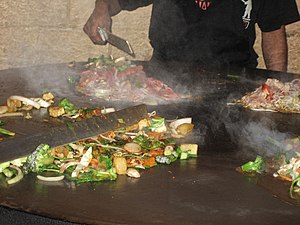


Mongolian barbecue (Chinese: 蒙古烤肉; pinyin: Měnggǔ kǎoròu; Wade–Giles: Mêng²-ku³ K'ao³-jou⁴) is a stir-fried dish that was developed in Taiwan during the 1950s.[1][2] Despite its name, the dish is not Mongolian and is only loosely related to barbecue.[3][4]

Mongolian barbecue was created by Taiwanese comedian and restaurateur Wu Zhaonan. A native of Beijing, Wu fled to Taiwan after the outbreak of the Chinese Civil War, and opened a street food stall in Yingqiao [zh], Taipei in 1951.[1][2] While he initially wished to name the dish "Beijing barbecue", due to political sensitivity associated with the city which had been recently designated as the capital of the People's Republic of China, the name "Mongolian barbecue" was chosen despite the lack of connection to Mongolia.[5]
Wu's food stall attracted a wide clientele including diplomats and wealthy businesspeople despite serving a relatively cheap and unsophisticated dish;[citation needed] however, it was later destroyed by flooding originating from a typhoon during which Wu almost drowned.[5] He was later able to develop a highly successful career as a comedian and left the restaurant business. Numerous imitators emerged to capitalize on the popularity of the dish he created, including Genghis Khan, Tang Palace, Great Khan, and Heavenly Khan.[5] The dish was later successfully introduced outside Taiwan.[3]
This section needs additional citations for verification. Please help improve this articlebyadding citations to reliable sources in this section. Unsourced material may be challenged and removed. (March 2023) (Learn how and when to remove this message)
|

Typically, diners select a variety of raw ingredients from a display of sliced meat (such as beef, pork, lamb, turkey, chicken, and shrimp) and vegetables (such as cabbage, tofu, onion, broccoli, and mushrooms). The bowl of ingredients is handed to the chef who then adds the diner's choice of sauce and is transferred to a grill.
The circular shape of the grill allows two or more chefs to cook food simultaneously and quickly and the food is typically prepared as the grill is revolved around. Oil or water may be added while the ingredients are stir-fried continuously over the high heat with the food items remaining intact.
Some American chains place the food on different parts of the round grill separated by a special wedge shaper. Each dish is stirred in its turn, as the operator walks around the outside of the grill and turns each individual's food in succession.
When cooking is complete, each finished dish is scooped into a bowl and handed to the diner. Many Mongolian barbecue restaurants follow an all-you-can-eat buffet format, allowing multiple visits to the grill.
|
| ||
|---|---|---|
| Dishes and meals |
| |
| Xiaochi |
| |
| Snacks and desserts |
| |
| Beverages |
| |
| Ingredients |
| |
| Chefs |
| |
| Miscellaneous |
| |